 French Navy – Standard 1500t destroyers, 14 built 1925-1931, in service until 1952: L’Adroit, Basque, Bordelais, Boulonnais, Brestois, Forbin, Frondeur, L’Alcyon, La Palme, La Railleuse, Le Fortuné, Le Mars, Foudroyant, Fougueux
French Navy – Standard 1500t destroyers, 14 built 1925-1931, in service until 1952: L’Adroit, Basque, Bordelais, Boulonnais, Brestois, Forbin, Frondeur, L’Alcyon, La Palme, La Railleuse, Le Fortuné, Le Mars, Foudroyant, FougueuxAfter a pause of many years complicated by the 1929 financial crash, the French admiralty obtained the construction of new “torpilleurs d’escadre”. They were as different as possible from the Bourrasque and L’Adroit classes, encompassing all technological and doctrinal changes since the 1920s. They were designed from 1931 to escort the upcoming Dunkerque class battleships, and they were a good mirror image of the largers Mogador class “super-destroyers”, inaugurating twin turrets for a total battery of six guns, two more than the usual French “torpilleurs”, as well as having more powerful engines (almost twice the output) for 37 knots and a much reinforced AA. Twelve ships were ordered the first laid down in 1936, but only seven were completed, most ended scuttled at Toulon in 1942. Some were raised fro the Regia Marina and towed to Genoa but never became operational.

Development
The main motivation behind the Hardi class was a considerable change in the French Fleet, with the arrival of the Dunkerque class fst battleships. They needed to be escorted, and thus, while still under design in 1931, were expected to reach 30 knots (56 km/h; 35 mph), which was equal to the sustained speed achievable by the 1920s L’Adroit-class destroyers. This was not sufficient for the Marine Nationale which wanted a margin of 3–4 knots (5.6–7.4 km/h; 3.5–4.6 mph) to escort the battlefleet, notably in order to venture out of the formation to hunt submarines or enemy torpedo boats and get back in line afterwards.
So a requirement was formulated for 38 knots (70 km/h; 44 mph) capable destroyer, a considerable improvement over the previous Bourrasque/L’Adroit classes. For this, it was requiped a much larger hull to coomodate an equally more massive powerplant to gain an extra 20-30,000 hp and achieve these speeds, while being still constrained by the London treaty on destroyer tonnage. A preliminary design was drafted that displaced about 1,400 tonnes (1,400 long tons) only, and the soltion to keep it compact was to have the four standard 130 mm guns (5.1 in) in two twin turrets rather than individual mounts. They were developed the following year but were too small to accommodate the propulsion machinery to achieve the intended speed.
Over the next two years of design work (1933-34) the new class was enlarged and to face the new, large destroyers of the Italian Navigatori and Japanese Fubuki classes (the French were present in Indochina), it was argued that they needed two more guns, six total, making for a larger, 1800t standard hull, the maximum authorized by the London treaty. These made them far larger and faster than the L’Adroits. This final design was eventually approved on 10 August 1934.
Design of the class
Hull and general design

The Le Hardi were larger destroyers than the 1920s generation for sure with an overall length of 117.2 metres (384 ft 6 in), beam of 11.1 metres (36 ft 5 in), draught of 3.8 metres (12 ft 6 in). To compare, this was 107.9 m x 9.84 m x 4.3 m for the previous L’Adroit designs. For displacement, this was an even greater increase, from 1,378 tonnes/2,000 tonnes standard/full load versus 1,800 tonnes (1,772 long tons) standard and 2,577 t (2,536 long tons) deep load for the new destroyers.
Construction was traditional, in welded and riveted steel frames, the hull shape in general wa smore elongated, with a broad prow, clipper bow, and same peculiar poop displayed on the previous classes. The silhouette looked far more elongated, stretched, and low vibility compared to the previous class. Instead of the prismatic, tall bridge of the previous class, there was now the new standard horseshoe style bridge with windows on 180° for a perfect peripheric vision, and an open observation bridge above. The only mase was no longer a tripod but a short wireless radio cable “cross-T” type support installed over the main fire control tower, rather than a tall tripod. The silhouette loked more modern with only two funels, both raked, the former being a bit larger.
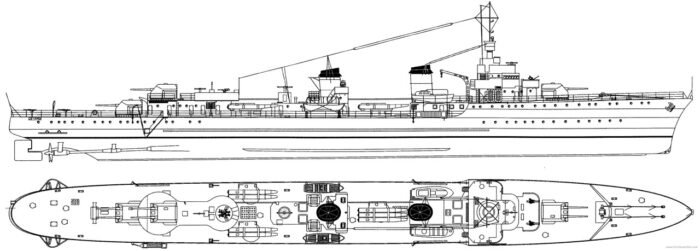
The other major changes were in the way the artilery and torpedo tubes were located, with an axial triple bank forward amidship between funnels, and two aft banks on either side aft alongside the beeefier structure which supported the main 37 mm AA mounts. On the previous designs, the two axial TT banks were located aft of the funnel. The hull was also divided by a dozen bulkheads for ASW protection, defining 13 watertight compartments. The crew consisted of 10 officers and 177 enlisted men, and they had two main vedettes (launches) operated by cranes behind the bridge, abaft the forefunnel, and two yawls abaft the aft funnel. Life rafts were installed wherever possible.
Powerplant
The Le Hardi-class ships were tailored to house a much beefier powerplant than the previous Torpilleurs. They were powered indeed by two geared steam turbines, whoich types differed betwen ships and yards. They each drove a single three-bladed 3.3-metre (10 ft 10 in) fixed pitch propeller. Steam came from four Sural-Penhöet (or Sural-Noguet) forced-circulation boilers, a new types developed for the late 1930s generation warships of the French Navy. They operated at a greater pressure, of 35 kg/cm2 (3,432 kPa; 498 psi) for a temperature of 385 °C (725 °F).
The standard was two sets of Rateau-Bretagne geared steam turbines but Casque, Le Corsaire, Mameluck and Le Téméraire had instead Parsons geared steam turbines.
The turbines could produce an output of 58,000 metric horsepower (42,659 kW; 57,207 shp) -to compare, 34,000 shp (25,000 kW) on previous Torpilleurs-. If initially the design speed was to be 38 knots, the tonnage limitation and limited capabilties of the new boilers limited speed to 37 knots (69 km/h; 43 mph). Le Hardi was the only ship which had time to run sea trials and comfortably exceeded that speedn 6 November 1939 at 39.1 knots (72.4 km/h; 45.0 mph), from 60,450 PS (44,461 kW; 59,623 shp). These ships carried 470 t (463 long tons) of fuel oil for a range of 3,100 nautical miles (5,700 km; 3,600 mi) at 10 knots (19 km/h; 12 mph) ot 1900 nautical miles at battle speed, 25 knots. To compare this, the Adroit class were only capable of 2,150 nm at 14 knots based on 340t of oil. The new destroyers were intended to follow the new Dunquerke class in the Atlantic indeed. In addition to their steam powerplant, the nex destoryers also had a pair of 100-kilowatt (130 hp) turbogenerators and a pair of 44-kilowatt (59 hp) diesel generators to feed their electric systems onboard, for all armament, fire control, and radio, when at anchor, engines cold.
Armament

From Pinterest
Canon de 130 mm/45 Modèle 1932
The main armament was a considerable step-up with six 45-caliber Canon de 130 mm Modèle 1932 instead of four single modele 1924. They were in twin-gun turrets, one forward on the forecastle, and two superfiring aft of the superstructure to keep stability. They were electrically powered and protected by 20 millimetres (0.8 in) armoured shields, more than most shields of the time only meant to stop shrapnel.
These new 130 mm guns could elevated from −10° to +30°.
Each had 170, 32.11-kilogram (70.8 lb) semi-armour-piercing (SAP) and 10 star shells for operations.
Muzzle velocity was 800 m/s (2,600 ft/s) and range 19,000 metres (21,000 yd) at 30°, so far more capable than the M1924.
These Modèle 1932 guns had a rate of fire of 10–15 rounds per minute.
however their rammer proved underpowered and often caused jams. Development time on these new mounts and training were severely lacking. It was exaplified in a engagement against a British destroyer in September 1940, when Épée could only fire 14 rounds in six minutes until all her artillery broke down. Le Hardi however at the Battle of Dakar performed afultlessly, firing 60 rounds without issue, and over 700 rounds during thirteen sessions on gunnery ranges.
Canon de 37 mm Modèle 1925 (1931)

The anti-aircraft (AA) battery of Le Hardi-class ships was also a step-up from the previous class, and instead of a 75 mm, they were tailored to carry twin-gun mounts for 70-caliber Canon de 37 mm (1.5 in) Modèle 1935 guns in a well placed position ensuring perfect arcs of fire at 360°. Development of these new mounts was however still in progress when completed in 1939–1940. So instead of these promising sets, two much older twin-gun mount 50-caliber Canon de 37 mm Modèle 1933 were installed. They were instead manually-loaded while still being able to elevate to +80° with a practical rate of fire of 15–21 rounds per minute, 2,960 rounds carried per gun. Muzzle velocity was 810 m/s (2,700 ft/s) for 0.73-kilogram (1.6 lb) shells and effective range 5,000 metres (5,500 yd).
Mitrailleuse Hotchkiss de 13,2 mm
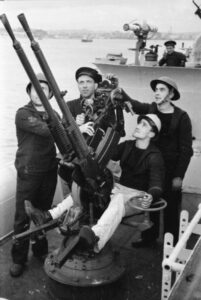
The ships were also fitted with two twin Hotchkiss 13.2 mm (0.52 in) Modèle 1929 AA machine gun mounts abreast the bridge on deck with a practical rate of fire of 250 rounds per minute, effective range of 2,500 metres (2,700 yd), supplied by Ready-use lockers with 480 rounds each near these, a remaining 1,920 rounds in magazines below deck.
⚙ specifications 13.2mm M1929 HMG
Mass 37.5 kg (83 lbs) per gun stripped.
Length: 1.67 m (5 ft 6 in), Barrel 1 m (3 ft 3 in)
Shell: 13.2×99mm Hotchkiss Long (1929).
Elevation -10° to +90°, traverse 360°, 450 rpm cyclic, 200-250 rpm sustained
Muzzle velocity: 800 m/s (2,625 ft/s)
Max range: 7.2 km (4.5 mi), Effective 4,200 m (13,800 ft)/45°
23D/DT 550mm TORPEDOES
The ships were unusual due to the placement of their AA mounts, and instead of two axial triple toirpedo tubes (or quadruple as this was the new standard) they only carried a single triple bank and two twin sets of 550-millimetre (21.7 in) torpedo tubes amidships. These twin-tube aft mounts on the broadside, combined to a the triple mounts meant a limited a rather weak 5-torpedo broadside.
The French developed the 19D Torpedoes designed at Toulon Arsenal. Slow in settings at 25-25 kts it had a better range of up to 15,300 yards (14,000 m). It was superseded for the Hardi class by the 23DT model (declined for submarines as the 24V/24M). Introduced in 1923, the “D” standing for destroyers, DT for destroyer leaders. It was still active in WW2 albeit in 1940 the Marine Nationale wanted a successor and looked for an Oxygen-powered model capable of 40-55 knots, 18 km (19.700 yards) range.

⚙ specifications 23D/DT TORPEDO
Weight: 4,560 lbs. (2,068 kg), for 27 ft. 2 in. (8.280 m) x 500 mm (21.7 inches).
Warhead: 683 lbs. (310 kg) TNT
Powered by a Schneider alcohol fed air heater, 4-cyl.
Speed settings: 9,840 yards/39 kts or 14,200 yards (13,000m)/35 kts
More
French Depth Charges
The ships dffered from previous designs as having a single depth charge chute built into the stern in the first batch of six instead of two, starboard. These carried eight 200-kilogram (440 lb) depth charges on a converyor belt. The port side of the stern was occupied by an handling gear for a towed Ginocchio captive anti-submarine torpedo. It was removed before completion, and the second batch had instead two depth charge chutes in the stern for 12 depth charges total.
They came out with a basic hydrophone, no proper sonar.
The depht charge used were of the Guiraud Model 1922.
Introduced in 1923, they Weighted 573 lbs. (260 kg) for a 441 lbs. (200 kg) charge for 50 x 88 cm (19.7 x 34.6 in).
Sink Rate or terminal velocity was 10 fps (3 meters per sec.) with 100, 165, 250 and 330 feet (30, 50, 75 and 100 m) settings, later augmented to 120m.
They were held in two Galle 8-6-DC roller chain racks at the poop, internal. Some sources spoke of two depth charge throwers on the aft weather deck but it’s dubious they were ever installed.
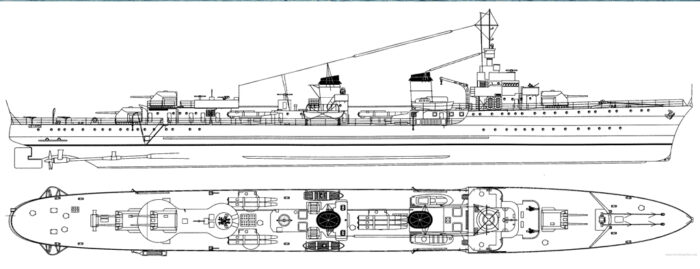
CC profile (HD in preparation)
⚙ Le Hardi class specs. |
|
| Displacement | 1,800 t (1,772 long tons) standard 2,577 t (2,536 long tons) deep load |
| Dimensions | 117.2 x 11.1 x 3.8m (384 ft 6 in x 36 ft 5 in x 12 ft 6 in) |
| Propulsion | 2 shafts and geared steam turbines, 4 forced-circulation boilers: 57,000 shp |
| Speed | 37 knots (69 km/h; 43 mph) |
| Range | 3,100 nmi (5,700 km; 3,600 mi) at 10 knots (19 km/h; 12 mph) |
| Armament | 3×2 130 mm, 1×2 37 mm AA, 2×2 13.2 mm AA, 1×3, 2×2 550 mm TTs, 2x DCT (8-12 DCs) |
| Armament | Gun turrets: 20 mm (0.8 in) |
| Sensors | Hydrophones, Radars (FNFL) |
| Crew | 187 officers and ratings |
Fire Control
The fire-control system was identical to that sported by the larger Mogador-class “contre-torpilleurs” (large destroyers). This was a director fitted with a 5-metre (16 ft 5 in) OPL Modèle PC.1936 stereoscopic rangefinder. It was built around the base of the foremast, above the bridge. This director sent the obtained range to the artillery center and then fed in turn the Modèle 1929 electro-mechanical computer, calculating a firing solution, transmitted to the turrets via internal displays. It was planned to have even an automatic gun laying and traverse automated from the director after completion of the ships, but that effort was stopped by 1942. Despite their generators, it was deduced that these ships still lacked the electrical capacity to power these systems.
There was in addition a planned, modern AA director, controlling the 37-millimetre M1935 guns. But agains, completion delays meant this became unavailable. So instead, a three-metre (9 ft 10 in) rangefinder on pedestal was substituted on all ships except Mameluk. She instead was given a new type of enclosed mounting with a five-meter rangefinder. The 13.2 mm HMG were guided by an high-angle one-point-five-metre (4 ft 11 in) rangefinder.
There was also a torpedo director, located above the primary gunnery director, at the foremast. It used a separate 5-meter OPL Modèle 1935 stereoscopic rangefinder. Bearing and range were sent to the electro-mechanical computer M1933 which calculated the torpedo firing angle, sent to the remotely controlled torpedo tubes. Fire command then could be automated frop the torpedo director or secondary positions on the bridge wings. Again, these systems were far more advance compared to the WWI era tech displayed by the Adroit/Bourrasque classes.
Wartime Modifications
-In early 1941, all ships under Vichy control were given extra single mounts for 0.5 inches Browning AA machine guns on the quarterdeck.
-By late 1941, Le Hardi had her twin Hotchkiss HMGs relocated to the quarterdeck and 2 single 25-mm Hotchkiss AA guns installed in their abaft the Bridge. In addition the Browning were transferred to newly built platforms eigher side of the superfiring turret aft.
-By early 1942, L’Adroit(ii), Casque and Mameluk were modernized the same. Navypedia precised they received in 1940 a twin 37mm/50 M1933 to replace the two single mounts, two twin 13.2mm/76 HMGs and up to five 8.80mm Hotchkiss AA MGs.
Evaluation
The “Le Hardi” (“The Bold”) class, initially twelve destroyers started from 1936 and expected all completed by 1941 were caught up by the war, and slow construction due to strikes and industrial bootlenecks. So a bit more than half was completed while the remaining five laid unfinished in june 1940, captured by the Germans, and under consideration for completion under Kriegsmarine standards. The seven that were seaworthy, sailed for French North Africa to prevent capture, then French West Africa (Le Hardi was present in the Battle of Dakar in September 1940). The Germans captured two under construction and due to local sabotages and eventual lack of interest, were abandoned in 1943.
The Vichy French Fleet reformed its High Sea Forces (‘Forces de haute mer’) by late June and when the Le Hardi class destroyers returned to France in November, three were assigned to the Forces de haute mer, the others placed in reserve for bugdetary and manpower reasons. They had no play in WW2 operations, being scuttled in Toulon in November 1942, as a result of the German invasion of the “Free zone” (Operation Lila) following the allied landings in North Africa (Operation Torch). The Regia Marina were invited to Toulon to salvage these ships in early 1943, which was partially successful. Only three were in good shape enough to be towed to Italy, Genoa for final repairs and conversion to Italian standard. All had been reassigned FR-numbers in between.
Work progressed slowly, so all were recaptured by the Germans after the September armistice. But little efforts were made to complete repairs. The former Lansquenet was perhaps the most advanced but slow priority and a lack of resources meant she was never operational until the end of the war. The three ships in Italy were scuttled in April 1945 to prevent capture by the Allies, the remaining ones in Toulon were sunk by Allied bombers or scuttled by the Germans. This was in August 1944 as part of Operation Dragoon. They were then all salvaged powstwar for scrap and the ones still in construction from 1939, BU on the slipway. L’Opiniâtre was launched, never completed and used for testing before scrapped in 1971. Lansquenet was refloated, towed back to Toulon in 1946, never completed and scrapped in 1958.
A sad story for the best “Torpilleurs” of the Marine Nationale, althought they were criticized for many points:
-To reach their intended speed they were lightly built and had a limited reserve for AA dn ASW or radar additions later on.
-The torpedo armament was awkward and weak for the time. Late 1930s destroyers adopted quadruple tubes, even quintuple in some case, whereas the French stuck to twin and triple banks, for a full torpedo broadside of only five torpedoes.
-The M1935 main armament was presented as semi-dual purpose, reaching 30° elevation, but the slow reload and traverse time plus poor AA direction negated this use.
-As customary for French Destroyers, even that late, they lacked good AA and ASW capabilities, with a primitive sonar system.
-While in French service until November 1942 they were never modernized or equipped with radar.
Construction
The first ship was authorized in the 1932 Naval Estimates to match the completion of the Dunkerque class. Construction however was significantly delayed by financial restrictions after the Great Depression. There was on top, a bilateral arms limitation talks between France and Fascist Italy. The Parliament thus suspended all new naval construction until 1934, which had severe consequences for all programs. Le Hardi herself thus was not laid down until late 1935 and her two sister ships only authorized in the 1935 Naval Estimates. Then mid-1936 Naval Estimates. The remaining six ships were authorized in the 1937, 1938 and 1938 bis Naval Estimates.
Construction as said in the evaluation, was slowed bye social unrest (from 1936 the new Popular front was elected, and widespread strikes halted many programs for more than a year).
These considerable industrial disruptions which hit all branches of the army (naval, air and army) affected everything revolving around the construction of Le Hardi class, initially set to be completed in 1938. Instead Le Hardi was the only ship completed in time to performed her sea trials in full, whowing the excellent potential of the class. The next four had their own acceptance trials in March-May 1940, enterung service in June only to flee France to North Africa to avoid capture. The most complete were also lacking equipment and manpower still. It was planned to complete remaining ships after the armistice but six were never completed due to the lack of resource and German opposition.
Career of Le Hardi class destroyers
 Le Hardi
Le Hardi
Le Hardi was laid down at Ateliers et Chantiers de la Loire, Nantes on 20 May 1936. She was launched on 4 May 1938 and only completed, commissioned on 2 June 1940 after full sea trials and shakedown. The Hardi alone completed her regulatory trials, reaching 39.1 knots. At she was completed in 1940, General Joseph Lafont, head of the French Scouts, provided the vessel’s sponsorship, and thus the three turrets bore the names “Louveteau”, “Scout”, and “Routier” wit the boats, and muzzle blasts, bore an insignia surmounted by a red cross potent, surrounded by the motto “Être prêt”, the scout’s motto. After the armistice she saw little activity. She escorted the ocean liner “Ville d’Oran” from La Pallice to Casablanca. On June 19, 1940, with her sisters Épée and Mameluck, she escorted the incomplete Jean Bart from Saint-Nazaire to Casablanca on the 22th.
On July 28, Hardi and Épée sailed for Dakar in French West Africa. During the British ahd FFL attack on Dakar on September 23-25, Le Hardi sortied to create a smoke screen to cover the light cruisers Georges Leygues and Montcalm. She fired 60 shells at the British ships, scoring no hits. She departed Dakar for Casablanca on September 30. In the next months she followed other sisters at Oran, in French Algeria, to escort the battleship Provence, damaged in the attack on Mers el-Kébir. She arrived there on October 25thn departed on November 5th, and in Toulon three days later. All Hardi-class ships were assigned to the 10th Torpedo Boat Division but only three were authorized to be maintained in permanent service, in accordance with new ruled from the Italian and German armistice commissions.
From July 3rd to 5th, Le Hardi escorted troop transports between Algiers and Marseille. She was assigned to the Forces de Haute Mer on August 18th. She was joined by the rest of the 10th Torpedo Boat Division, Épée and Mameluck, on November 1st but was placed in reserve on May 20th, 1942. Like her sisters she returned to Toulon, and was scuttled on 27 November 1942, raised as FR37 towed to Genoa and scuttled there by the Germans on 20 April 1945.
 Fleuret
Fleuret
Fleuret (“foil”) (later renamed Foudroyant) was laid down at Forges et Chantiers de la Méditerranée, La Seyne-sur-Mer on 18 August 1936, launched on 28 July 1938 and completed on 11 June 1940. She was scuttled 27 November 1942; raised as FR36, scuttled, Toulon, 17 August 1944
 Épée
Épée
Épée (“sword”) (later renamed L’Adroit) was laid down at Forges et Chantiers de la Gironde, Bordeaux on 15 October 1936, launched on 26 October 1938 and completed on 14 June 1940.
Scuttled 27 November 1942; raised as FR33, sunk February 1944

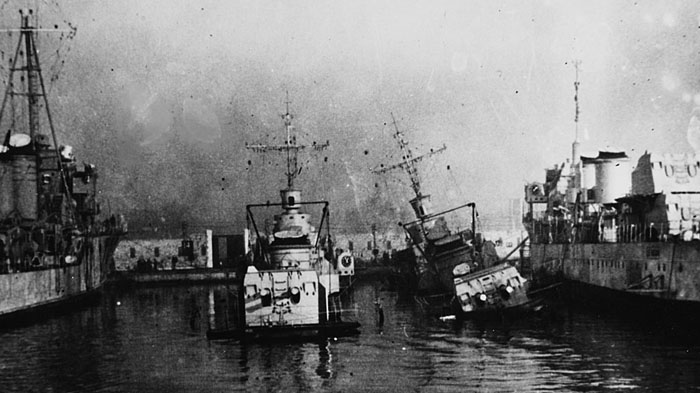
Mameluk was laid down at Ateliers et Chantiers de la Loire, Nantes on 1 January 1937, launched on 18 February 1939 and commissioned on 17 June 1940.
Scuttled, 27 November 1942.
 Casque
Casque
Casque (“helmet”) was laid down at Forges et Chantiers de la Méditerranée, La Seyne-sur-Mer on 30 November 1936, launched on 2 November 1938 and completed on 20 June 1940.
 Lansquenet
Lansquenet
Lansquenet (“Landsknecht”) (later renamed “Cyclone”) was laid down at Forges et Chantiers de la Gironde, Bordeaux on 17 December 1936, launched on 20 May 1939. Never completed. Scuttled on 27 November 1942. Raised as FR34 for the Regia Marina, towed to Genoa, but never repaired, recaptured by the Germans after September 1943, renamed TA34, scuttled in March 1945.
 Le Flibustier
Le Flibustier
Le Flibustier (“Filibustier” later renamed Bison) was laid down at Forges et Chantiers de la Méditerranée, La Seyne-sur-Mer on 11 March 1938, launched on 14 December 1939 but never completed. She too, was captured on 27 November 1942 by the Germans, renamed FR35 for the Italian Navy, never completed and sank by US aviation in 1944.
 Le Corsaire
Le Corsaire
Le Corsaire (“Corsair”, later renamed Sirocco) was laid down at Forges et Chantiers de la Méditerranée, La Seyne-sur-Mer on 31 March 1938, launched 14 November 1939 but completed on 1st July 1941 (June 1940 initially). She was completed, bu scuttled on 27 November 1942. Raised as FR32 for the Italian Navy, towed to Genoa for repairs but scuttled on 20 October 1944 by the Germans.
 L’Intrépide
L’Intrépide
L’Intrépide was laid down on 16 August 1939 at F C de la Méditerranée, La Seyne, launched on 26 June 1941 under Vicjy control but never completed, and scrapped postwar.
 Le Téméraire
Le Téméraire
Le Téméraire was laid down at F.C. de la Méditerranée, La Seyne on 28 August 1939, launched on 7 November 1941, but completion under Vichy control was abandoned in November 1941.
 L’Opiniâtre
L’Opiniâtre
L’Opiniâtre (‘obstinate’) was laid down at Forges et Chantiers de la Gironde, Bordeaux on 1 August 1939. She was captured in June 1940, under German control, intended for completion for the Kriegsmarine as ZF6, then ZF2, never completed and destroyed in the summer of 1944.
L’Aventurier was laid down at Forges et Chantiers de la Gironde, Bordeaux on 4 August 1939. Still on slip in early constrution stage in June 1940. Intended to be completed by the Germans as ZF7. She was launched on 20 April 1947 as is, to leave the slipway, and used afterwards as an experimental hulk postwar. She was sold for BU on 21 April 1971.
None of these ships still recoverable were completed to be modenrized and reused postwar as the hull was looking too small for the new French cold war doctrine.
Succession: Modified Corsaire and Desaix class Destroyers
In 1938 as the ships were in construction, experiences of ships attacked by aircraft while performing neutrality patrols in the Spanish Civil War led the État-major de la marine (Naval General Staff) to revise assumptions about a naval war and seeing a dual-purpose armament more desirable in order to escort capital ships. Le Hardi class were thus revised and for the last four ships scheduled to be laid down in mid-1939 it was believed they would be modified to accept new M1935 DP guns. Three proposals were submitted on 30 November 1938, all on a hull eventually was enlarged by more than 400 tonnes (390 long tons). That could have been more, but by then, all treaties were not yet by the windows. Full load would have been probably around 3,200 tonnes.
The staff accepted two proposals, and the first of a batch of three ships were to be armed with 130 mm DP mounts derived from the Dunkerque-class, and the remaining fourth armed with the standard 130 mm low-angle mount. They were to forme a three-ship division with Le Corsaire and Le Flibustier. The AA armament was to comprise twin 100-millimetre (3.9 in) high-angle mounts in place of the axial torpedo-tube mount forward amidships. The standard pair of twin-gun AA machine gun mounts wa salso modernized and the aft pair of twin tubes replaced by triple mounts.
In September 1939, building was suspended. Many shipyard workers and personal were enlisted in the army. Constrition was resumed in March 1940, but Admiral François Darlan at the head of the Chief of Staff, was informed they would not enter service before 1944 and with four Le Fier-class TBs possibly have sea trials in 1943. On 28 April her conformed to adopt modified Le Hardi designs with the initial or modified hull depending on the design advanced. He wanted a top speed of 35.5–36 knots (65.7–66.7 km/h; 40.9–41.4 mph), range of 1,700 nmi (3,100 km; 2,000 mi) at 20 knots (37 km/h; 23 mph). The final design was of 2,180t standard and 60,000 hp for 37 knots.
The armament of these new ships was of three 130-millimetre DP turrets elevating up to 40-50°. It became clear they would not be ready before completion, so an interim armament was proposed of three or four 100-millimetre guns turrets high-angle mounts. There was also one twin and two single 37mm AA mounts and two twin-gun AA HMGs, two triple torpedo banks, two depth charge racks and two depth charge throwers for new 100 kgs depth charges. Needless to say, these plans were shattered by the November 1942 allied assault on North Africa and German invasion of the “free zone”.
Before this alternative design, in May 1938, there were plans for extra classes of escorts for the new upcoming Richelieu class battelships and their future sisters, the Gascoigne sub-class. This new class would be called the Desaix. They weere successors of the Mogadors and “contre-torpilleurs” so in parallel of the improved Corsaire class. When approved Desaix, Hoche, Kleber and Marceau were to be followed by another batch of six ships approved in April 1940. The first were planned the completion around 1942, 1943 fo the next one. They were never laid down. They featured this time and adequate electrical installation thanks to feedback from the Mogador in service. Theit rudder was redesigned, and they were beefier at 3,000 tons standard, 4,100 fully loaded for 139 m long, 13 m wide, 100,000 hp for 40 knots, four twin 130mm/50 HA mounts, a new fire automated control system, two twin 37 mm, two quad 13.2 mm mounts, 2×3 torpedo tubes.
Read More/Src
Books
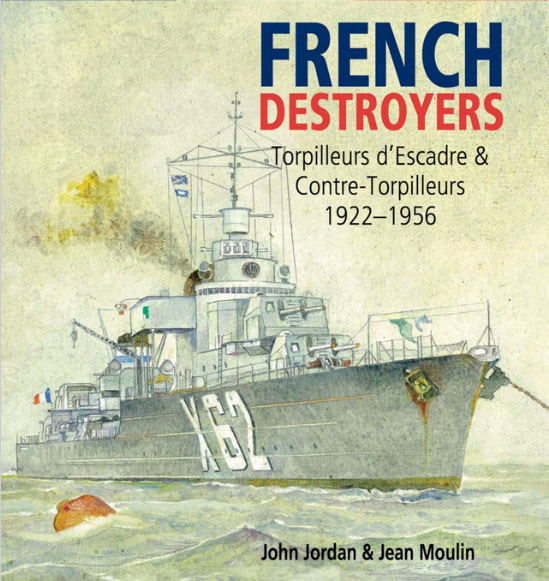
Campbell, John (1985). Naval Weapons of World War II. Annapolis, Maryland: Naval Institute Press..
Cernuschi, Enrico & O’Hara, Vincent P. (2013). “Toulon: The Self-Destruction and Salvage of the French Fleet”. In Jordan, John (ed.). Warship 2013.
Jordan, John & Moulin, Jean (2015). French Destroyers: Torpilleurs d’Escadre & Contre-Torpilleurs 1922–1956. Barnsley, UK: Seaforth Publishing.
Roberts, John (1980). “France”. In Chesneau, Roger (ed.). Conway’s All the World’s Fighting Ships 1922–1946.
Rohwer, Jürgen (2005). Chronology of the War at Sea 1939–1945: The Naval History of World War Two (Third Revised ed.). NIP
Whitley, M. J. (1988). Destroyers of World War Two: An International Encyclopedia. NIP.
Links
https://www.navypedia.org/ships/france/fr_dd_le_hardi.htm
https://en.wikipedia.org/wiki/Le_Hardi-class_destroyer
https://fr.wikipedia.org/wiki/Classe_Hardi
https://en.wikipedia.org/wiki/Canon_de_130_mm_Mod%C3%A8le_1932_and_1935
https://forum.warthunder.com/t/le-hardi-state-of-the-art-french-destroyer/14012
Model Kits
None found.

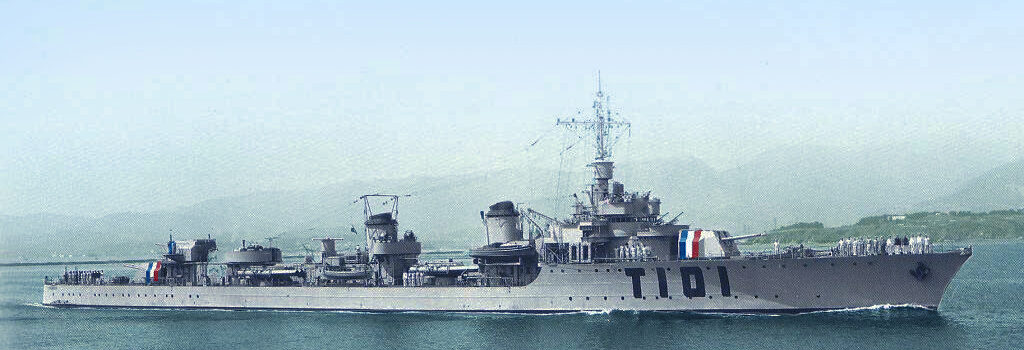
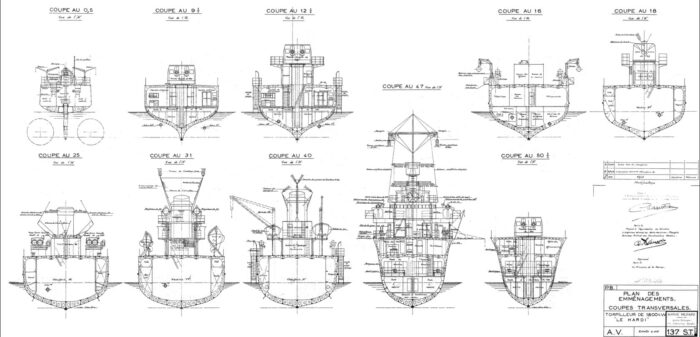
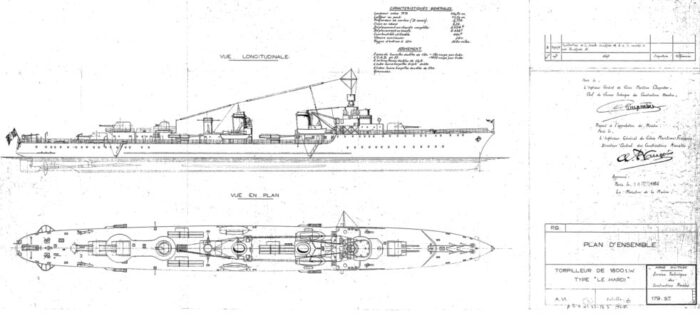



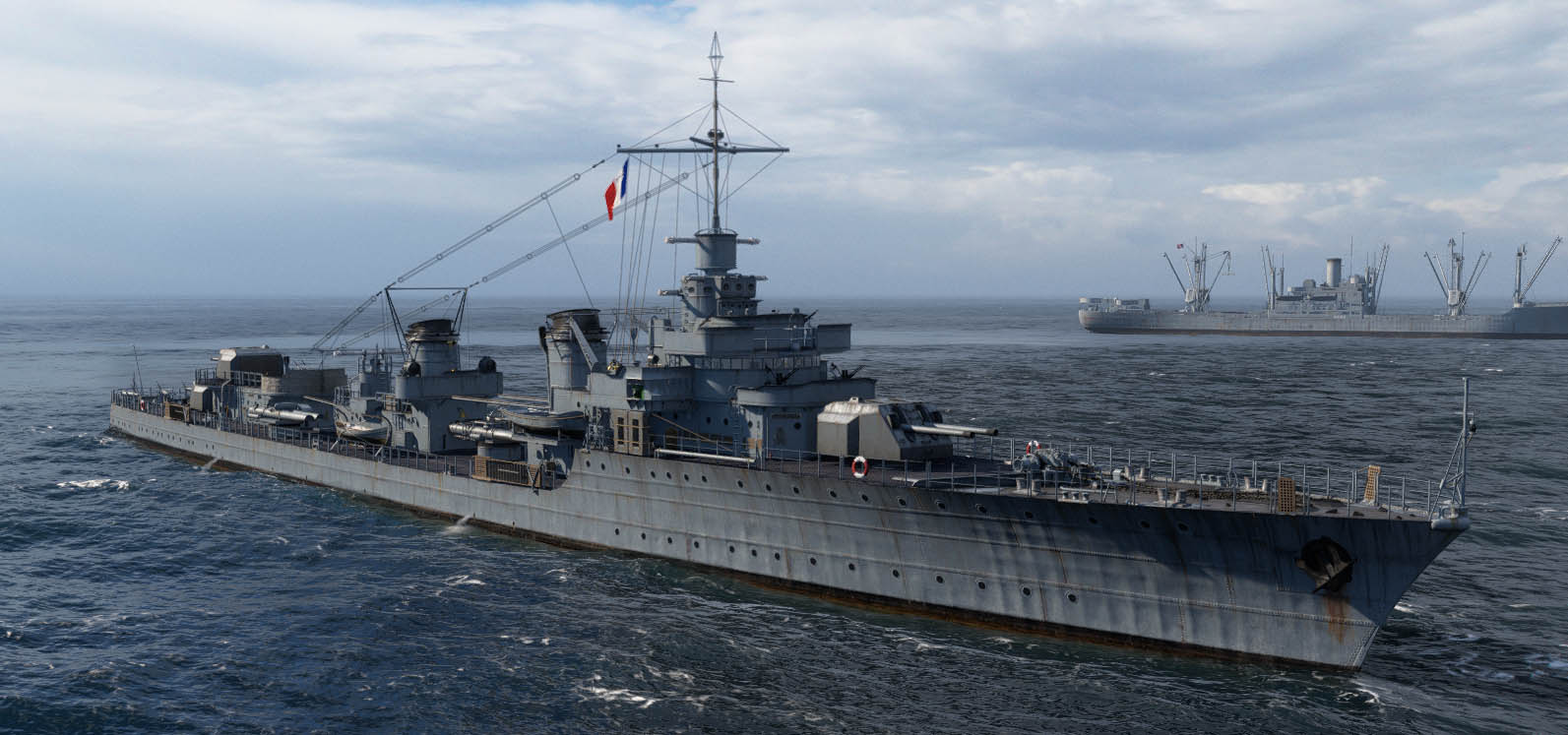

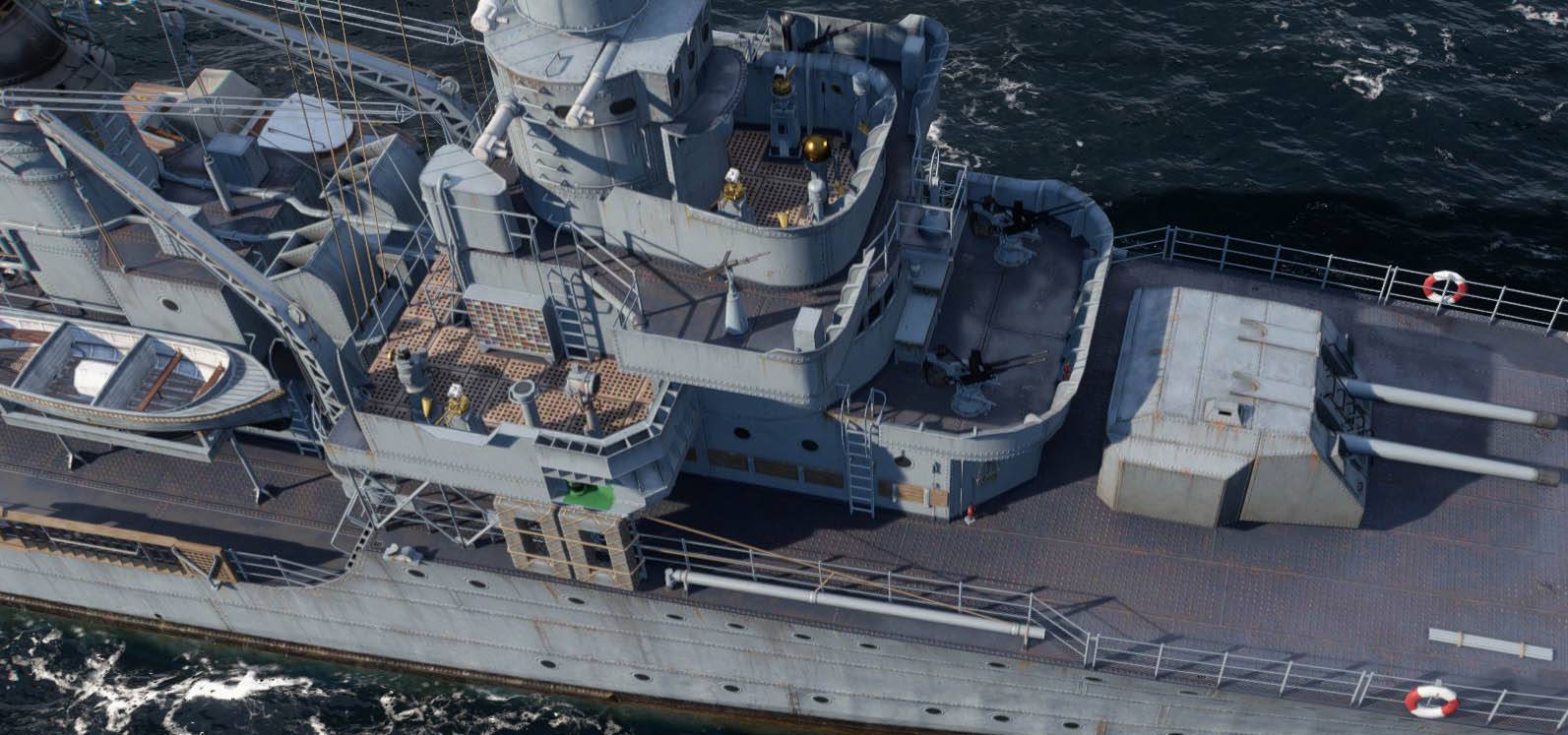
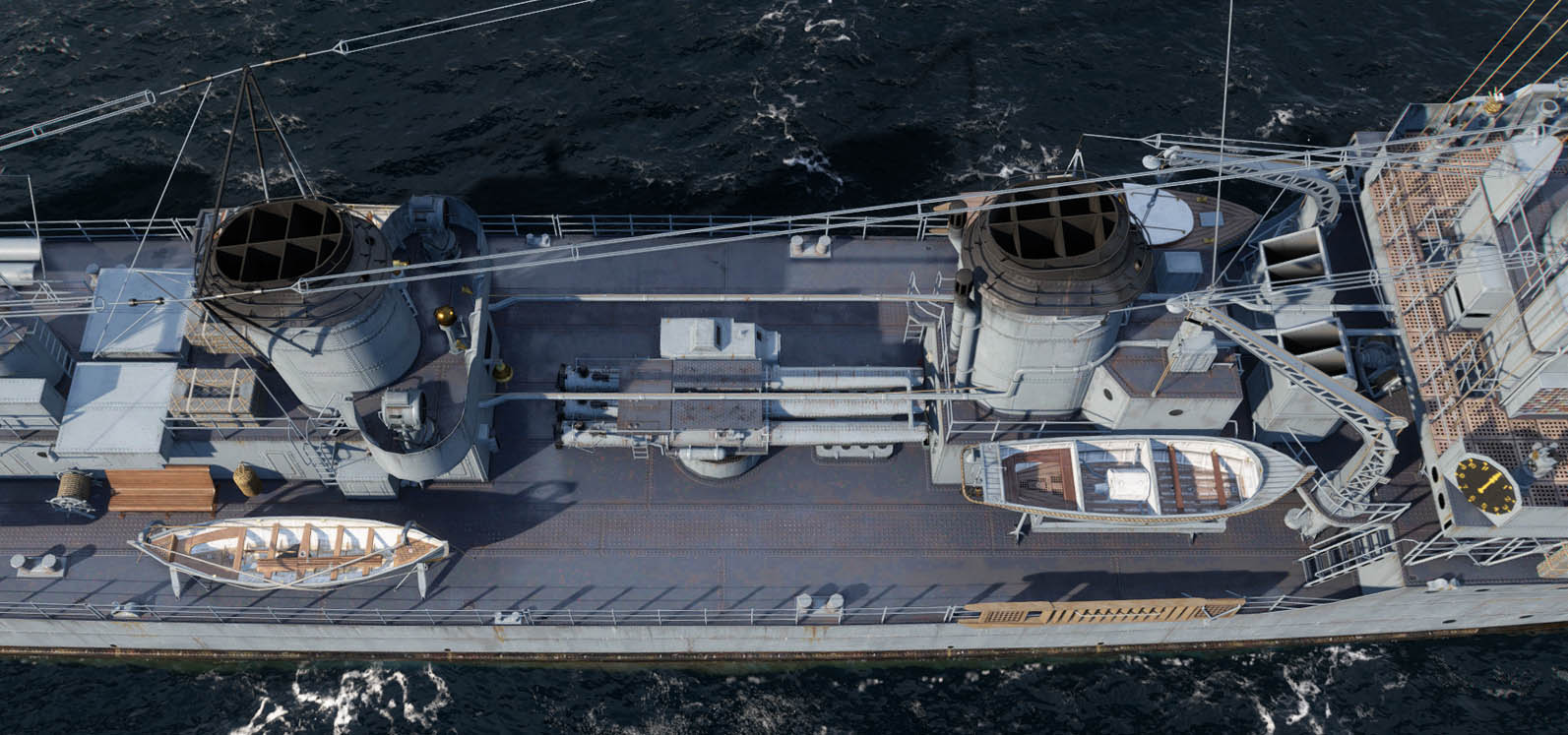
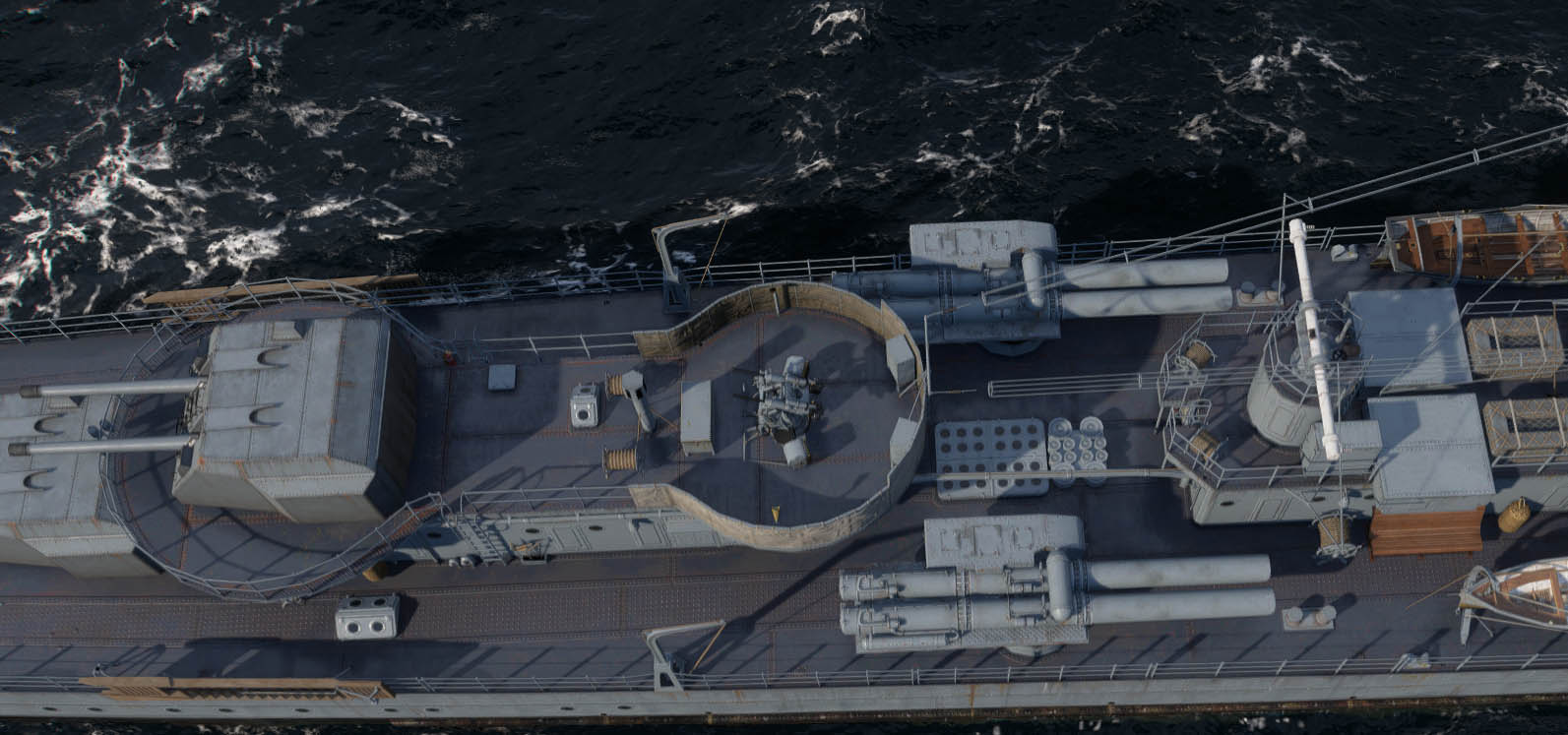
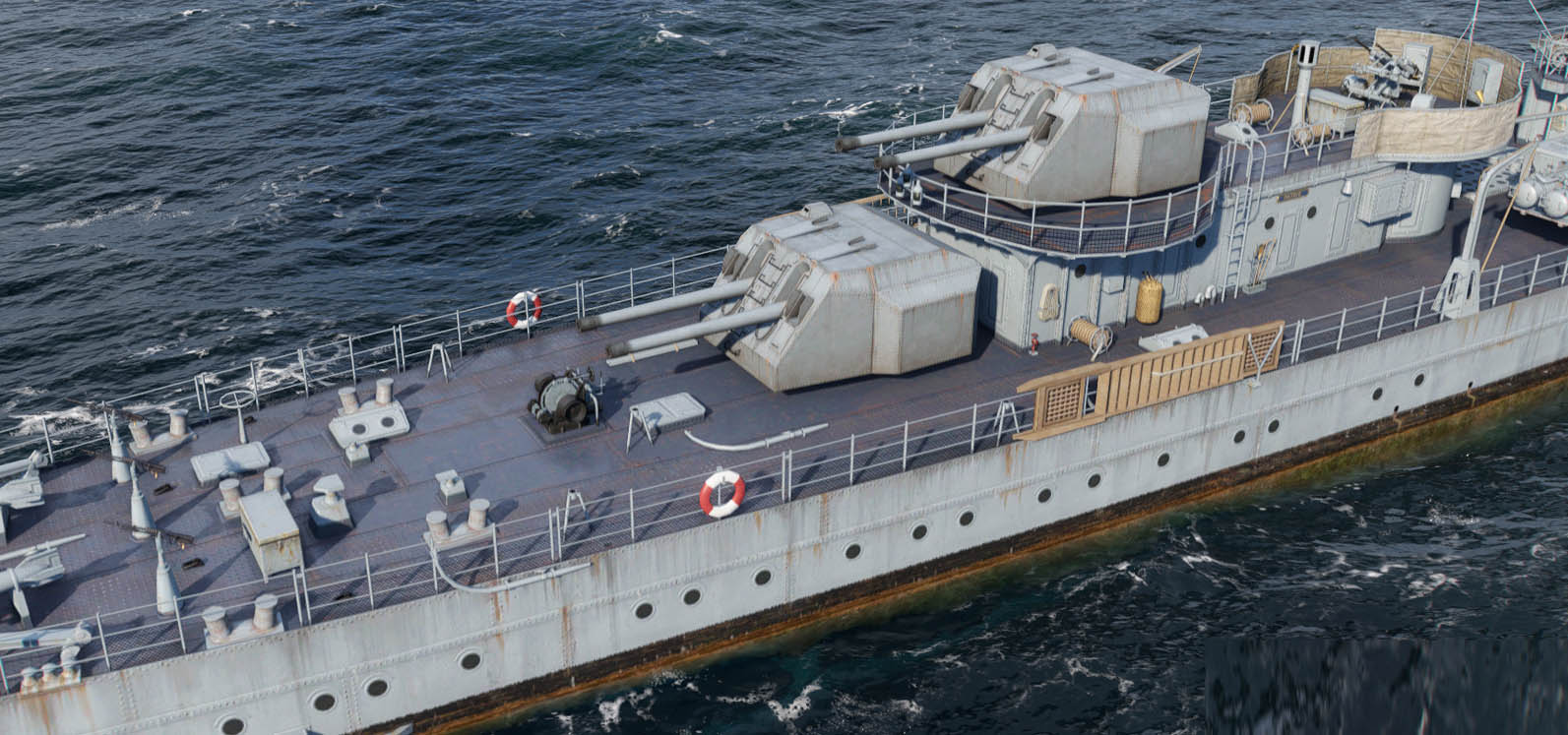
 Latest Facebook Entry -
Latest Facebook Entry -  X(Tweeter) Naval Encyclopedia's deck archive
X(Tweeter) Naval Encyclopedia's deck archive Instagram (@navalencyc)
Instagram (@navalencyc)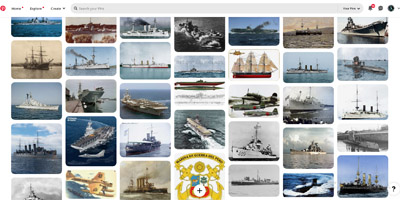

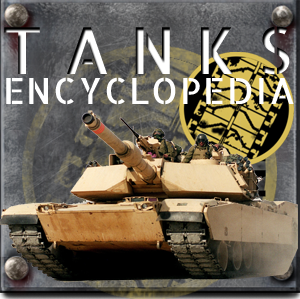
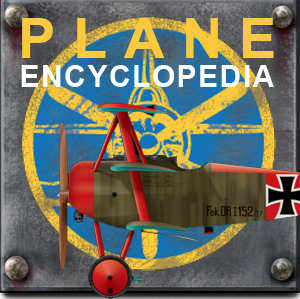
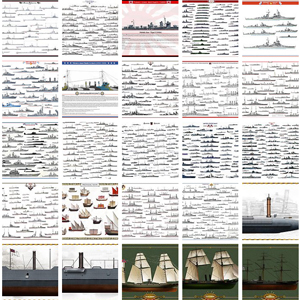
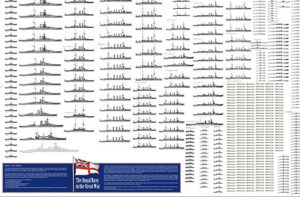
 French Navy
French Navy Royal Navy
Royal Navy Russian Navy
Russian Navy Armada Espanola
Armada Espanola Austrian Navy
Austrian Navy K.u.K. Kriegsmarine
K.u.K. Kriegsmarine Dansk Marine
Dansk Marine Nautiko Hellenon
Nautiko Hellenon Koninklije Marine 1870
Koninklije Marine 1870 Marinha do Brasil
Marinha do Brasil Osmanlı Donanması
Osmanlı Donanması Marina Do Peru
Marina Do Peru Marinha do Portugal
Marinha do Portugal Regia Marina 1870
Regia Marina 1870 Nihhon Kaigun 1870
Nihhon Kaigun 1870 Preußische Marine 1870
Preußische Marine 1870 Russkiy Flot 1870
Russkiy Flot 1870 Svenska marinen
Svenska marinen Søværnet
Søværnet Union Navy
Union Navy Confederate Navy
Confederate Navy Armada de Argentina
Armada de Argentina Imperial Chinese Navy
Imperial Chinese Navy Marinha do Portugal
Marinha do Portugal Mexico
Mexico Kaiserliche Marine
Kaiserliche Marine 1898 US Navy
1898 US Navy Sovietskiy Flot
Sovietskiy Flot Royal Canadian Navy
Royal Canadian Navy Royal Australian Navy
Royal Australian Navy RNZN Fleet
RNZN Fleet Chinese Navy 1937
Chinese Navy 1937 Kriegsmarine
Kriegsmarine Chilean Navy
Chilean Navy Danish Navy
Danish Navy Finnish Navy
Finnish Navy Hellenic Navy
Hellenic Navy Polish Navy
Polish Navy Romanian Navy
Romanian Navy Turkish Navy
Turkish Navy Royal Yugoslav Navy
Royal Yugoslav Navy Royal Thai Navy
Royal Thai Navy Minor Navies
Minor Navies Albania
Albania Austria
Austria Belgium
Belgium Columbia
Columbia Costa Rica
Costa Rica Cuba
Cuba Czechoslovakia
Czechoslovakia Dominican Republic
Dominican Republic Haiti
Haiti Hungary
Hungary Honduras
Honduras Estonia
Estonia Iceland
Iceland Eire
Eire Equador
Equador Iran
Iran Iraq
Iraq Latvia
Latvia Liberia
Liberia Lithuania
Lithuania Mandchukuo
Mandchukuo Morocco
Morocco Nicaragua
Nicaragua Persia
Persia San Salvador
San Salvador Sarawak
Sarawak Uruguay
Uruguay Venezuela
Venezuela Zanzibar
Zanzibar Warsaw Pact Navies
Warsaw Pact Navies Bulgaria
Bulgaria Hungary
Hungary

 Bundesmarine
Bundesmarine Dutch Navy
Dutch Navy Hellenic Navy
Hellenic Navy Marina Militare
Marina Militare Yugoslav Navy
Yugoslav Navy Chinese Navy
Chinese Navy Indian Navy
Indian Navy Indonesian Navy
Indonesian Navy JMSDF
JMSDF North Korean Navy
North Korean Navy Pakistani Navy
Pakistani Navy Philippines Navy
Philippines Navy ROKN
ROKN Rep. of Singapore Navy
Rep. of Singapore Navy Taiwanese Navy
Taiwanese Navy IDF Navy
IDF Navy Saudi Navy
Saudi Navy Royal New Zealand Navy
Royal New Zealand Navy Egyptian Navy
Egyptian Navy South African Navy
South African Navy






























 Ukrainian Navy
Ukrainian Navy dbodesign
dbodesign